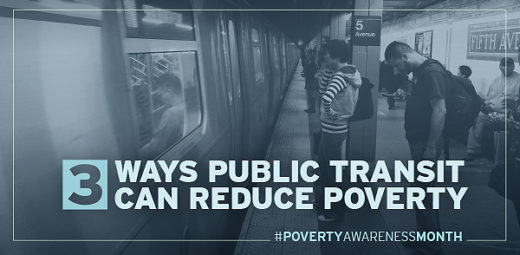
Jan 163 Ways Public Transit Can Reduce Poverty
Transportation matters — especially when you’re struggling to make ends meet. Getting to work or receiving proper healthcare is easier with good public transportation like buses, subways, and light-rails. Plus, it can be cheaper than a car. Communities should continue to discover more ways to make safe, affordable public transit possible for people with low incomes. Here are three ways improving public transit helps communities to stay vibrant and healthy.
 1. Reduce Commute Time
1. Reduce Commute Time
A Harvard study found that commute time is the biggest indicator as to whether or not a person can escape poverty. The longer your commute, the more likely you are to be late to important things, and you have less time with your family. Increasing public transit’s efficiency and reach can make a big impact.
*source: The Impacts of Neighborhood on Intergenerational Mobility
 2. Save Money
2. Save Money
A household can save an average of $10,000 annually by taking public transit. Owning a car costs between $6,000 and $12,000 a year — it’s not cheap. If we keep fares affordable, more people have access to the transportation they need.
*source: American Public Transportation Association
 3. Better Health
3. Better Health
Transportation barriers like long commutes and car problems can lead to missed doctors’ appointments. If you’re living on a low income, that’s expensive and hard to schedule with work. A study found that anywhere between 10%, all the way up to 51%, of people in some states said that bad transportation is a barrier to their healthcare.
*source: Journal of Community Health
Mercy Housing is passionate about transportation too. This is why we create transit-oriented communities. Wondering what that is? Sign up for our newsletter and check out our blog.
No related posts.
Stay Up To Date
Get news on Mercy Housing and inspiring stories of change delivered to your inbox.


